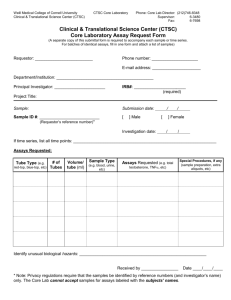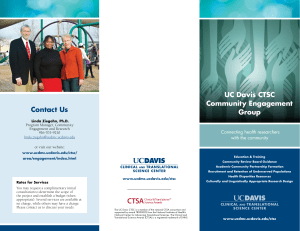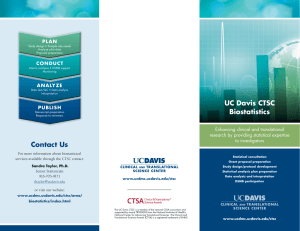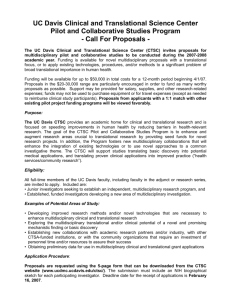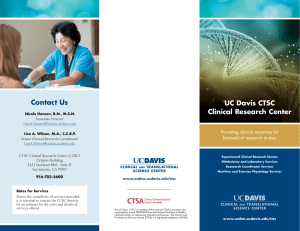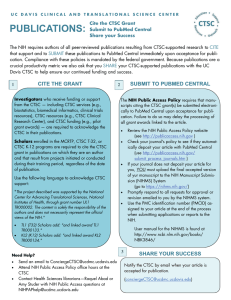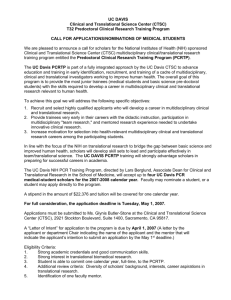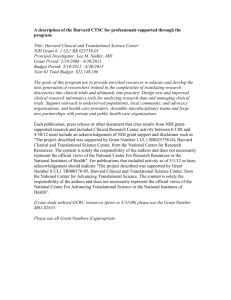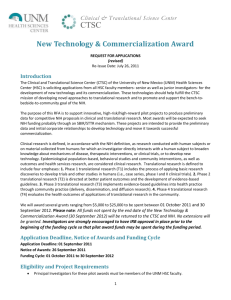Julie Freischlag encourages collaborative research among clinicians and scientists
advertisement
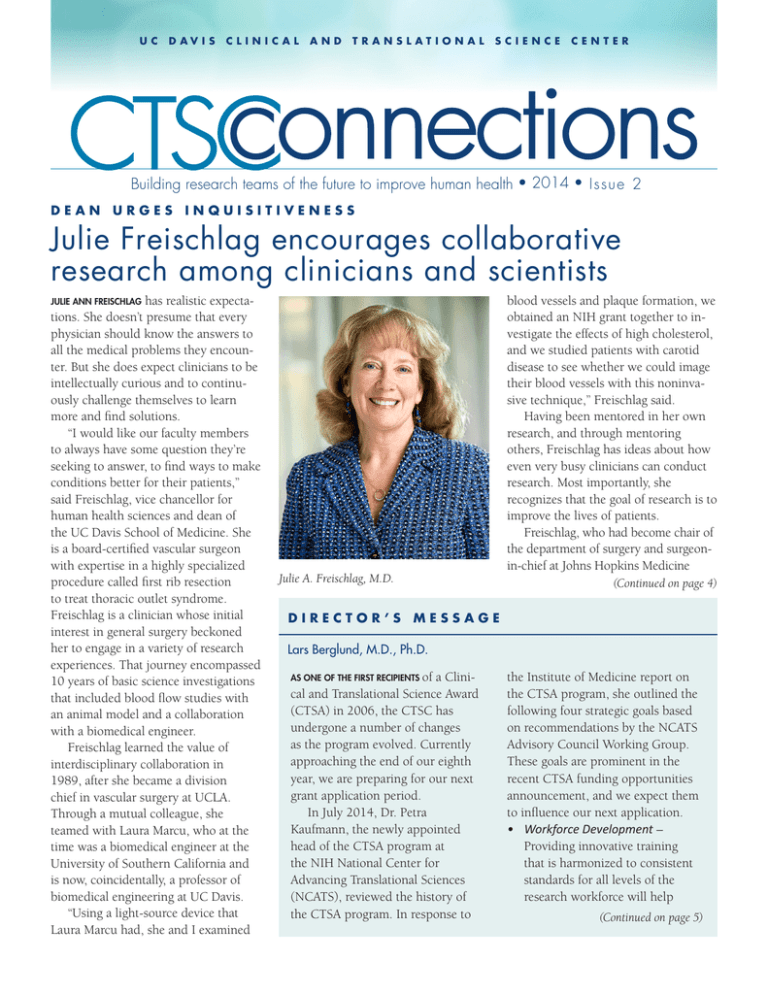
UC D AV I S CLINICAL AND TRANSLATIONAL SCIENCE CENTER Building research teams of the future to improve human health • 2014 • I ssue 2 DEAN URGES INQUISITIVENESS Julie Freischlag encourages collaborative research among clinicians and scientists has realistic expectations. She doesn’t presume that every physician should know the answers to all the medical problems they encounter. But she does expect clinicians to be intellectually curious and to continuously challenge themselves to learn more and find solutions. “I would like our faculty members to always have some question they’re seeking to answer, to find ways to make conditions better for their patients,” said Freischlag, vice chancellor for human health sciences and dean of the UC Davis School of Medicine. She is a board-certified vascular surgeon with expertise in a highly specialized procedure called first rib resection to treat thoracic outlet syndrome. Freischlag is a clinician whose initial interest in general surgery beckoned her to engage in a variety of research experiences. That journey encompassed 10 years of basic science investigations that included blood flow studies with an animal model and a collaboration with a biomedical engineer. Freischlag learned the value of interdisciplinary collaboration in 1989, after she became a division chief in vascular surgery at UCLA. Through a mutual colleague, she teamed with Laura Marcu, who at the time was a biomedical engineer at the University of Southern California and is now, coincidentally, a professor of biomedical engineering at UC Davis. “Using a light-source device that Laura Marcu had, she and I examined JULIE ANN FREISCHLAG Julie A. Freischlag, M.D. blood vessels and plaque formation, we obtained an NIH grant together to investigate the effects of high cholesterol, and we studied patients with carotid disease to see whether we could image their blood vessels with this noninvasive technique,” Freischlag said. Having been mentored in her own research, and through mentoring others, Freischlag has ideas about how even very busy clinicians can conduct research. Most importantly, she recognizes that the goal of research is to improve the lives of patients. Freischlag, who had become chair of the department of surgery and surgeonin-chief at Johns Hopkins Medicine (Continued on page 4) DIRECTOR’S MESSAGE Lars Berglund, M.D., Ph.D. AS ONE OF THE FIRST RECIPIENTS of a Clinical and Translational Science Award (CTSA) in 2006, the CTSC has undergone a number of changes as the program evolved. Currently approaching the end of our eighth year, we are preparing for our next grant application period. In July 2014, Dr. Petra Kaufmann, the newly appointed head of the CTSA program at the NIH National Center for Advancing Translational Sciences (NCATS), reviewed the history of the CTSA program. In response to the Institute of Medicine report on the CTSA program, she outlined the following four strategic goals based on recommendations by the NCATS Advisory Council Working Group. These goals are prominent in the recent CTSA funding opportunities announcement, and we expect them to influence our next application. • Workforce Development – Providing innovative training that is harmonized to consistent standards for all levels of the research workforce will help (Continued on page 5) TEAM SCIENCE CTSC pilot project ignites innovation Focus on positron emission tomography (PET) imaging to detect efficacy of new therapies for arthritis with career“We’re about to begin a trial under takes approximately three months threatening wrist pain could not have sponsorship of a drug company that to detect with conventional physical imagined that technology intended seeks to demonstrate a quantifiable examinations. In the pilot study that for breast cancer imaging could lead response to one of their biologic Badawi led in collaboration with to resolution of her painful arthritis. drugs using this technology. We are rheumatologists, radiologists and Fortunately for her, a UC Davis also engaged in another industry trial physicists, a high-resolution PET/ researcher did envision that possibility sponsored by a leading manufacturer computed tomography (CT) scanner – a connection he made as a result of imaging equipment. In addition, that had been built in his laboratory to of serving as a trainee on a research we have a pending NIH grant to study detect breast cancer was able to reveal project that began as a pilot project parametric imaging of the wrist and to such responses in the arthritic wrists of awarded through the CTSC. develop a method to obtain absolute research subjects only one month after The researcher, Abhijit J. Chaudhari, treatment began. numbers relating to blood flow and was among several trainees metabolic rate of the tissue, on a funded CTSC pilot which also are very relevant,” project titled “3D Molecular, Badawi said. Functional and Anatomic Chaudhari, who had been Imaging of Response in Badawi’s postdoctoral fellow Rheumatoid Arthritis,” which for the pilot project, subseRamsey D. Badawi initiated quently obtained a faculty in 2007. Badawi, an associate appointment as an assistant professor of radiology and professor of radiology. With biomedical engineering who Badawi’s encouragement, now is chief of the Division Chaudhari assumed the role of Nuclear Medicine, learned of principal investigator of that rheumatologists and the wrist study, which has musculoskeletal radiologists evolved into a musculoskelehad been seeking a way to tal imaging research program compress the time needed to that has germinated several Biomedical researcher Ramsey Badawi, Ph.D., examines the breast evaluate the effects of new other studies. PET scan technology in development. drug therapies for rheumatoid “With a colleague, Abhijit arthritis. developed a technique “New drugs to treat rheumatoid Badawi’s initial results from the pilot for creating motion imagery of the arthritis are very expensive and have wrist using MRI. They used this new study enabled him to secure matchside effects that could compromise method to help a surgeon localize the ing funds from the Division of Nuclear the immune system. Patients do much source of clicking and pain in the sign Medicine. Continuation of Badawi’s rebetter when they are put on the right language specialist’s wrist, which led search yielded an even more important drug quickly. The trick is to find the to surgical options to fix it. Translation discovery about psoriatic arthritis. right drug for a particular patient,” of a research project into patient care “The high resolution of our explained Badawi, a medical physicist so quickly is pretty rare,” Badawi images showed for the first time who specializes in positron emission observed. “Abhijit’s successful wrist that inflammation of the fingernail tomography (PET). work is strongly related to our pilot bed associated with psoriatic X-ray and magnetic resonance project funding through the CTSC.” arthritis is intimately connected with imaging (MRI) are not sufficiently To date, work begun under Badawi’s inflammation of an extensor tendon sensitive to detect the early changes pilot project has resulted in 10 peerthat inserts into the nail bed. That that such therapies may initiate. In finding was not demonstrated before (Continued on page 4) most cases, response to treatment we conducted the study,” Badawi said. A SIGN LANGUAGE INTERPRETER 2 UC Davis Clinical and Translational Science Center • 2014 • Issue 2 PROGRAM PROFILE Pilot translational and clinical studies program: A model for collaboration, training and research excellence THE CTSC PILOT PROGRAM, officially known as the Pilot Translational and Clinical Studies Program, is a key component of the UC Davis CTSC that sparks innovation and fosters team science. Since its inception in 2006, the CTSC has stimulated novel partnerships that are generating new scientific knowledge to improve health, from the development of novel PET imaging tools for rheumatoid arthritis, to mechanisms by which human milk shapes the infant intestinal microbiota, to community-based research on family concerns and ideas on diabetes and obesity prevention. As one of the first pilot programs requiring the participation of trainees in funded projects, the UC Davis CTSC approach has become a model widely embraced throughout the campus and beyond. The posting of program details, including a list of all funded investigators and project titles on the CTSC website, has ensured widespread distribution to various audiences. In keeping with the spirit of the CTSC as a partnership program and to give prospective pilot project applicants impetus to utilize the full breadth of CTSC resources, the calls for applications have been closely linked with ongoing translational concepts. In many cases, these concepts have been identified and refined in translational workshops and symposia. Participants in the workshops have been informed about pilot project opportunities, and outcomes of the workshops have provided the foundation for collaborative submissions. Creating an environment that fosters rich and productive research partnerships and collaborations is an important focus of the program. The CTSC has maximized and leveraged calls for pilot project applications and planning grants, reaching out to centers and programs across disciplines at UC Davis, from the Alzheimer’s Disease Center and Center for Healthcare Policy and Research to the Children’s Miracle Network and Comprehensive Cancer Center, to name a few. These efforts have resulted in $68 million in new grant funding and publication in prestigious scientific journals. To ensure cross-fertilization among investigators and trainees and emphasize key clinical and translational concepts, the program hosts an annual retreat to share research outcomes and to highlight new technologies, methodologies, therapies and community outreach efforts. A thematic focus is selected annually (e.g., technology transfer, biorepositories) with a keynote speaker from another CTSA site. These retreats have been highly effective in team building and forming new partnerships, engaging faculty and their trainees in the CTSC program, and enhancing communications on crucial clinical and translational topics. The successful concepts of the CTSC Pilot program have been extended to other NIH programs, such as the UC Center for Accelerated Innovation and the West Coast Metabolomics Center Pilot and Feasibility Projects. We also have developed strong ties with the College of Engineering by funding collaborations between engineering students and School of Medicine faculty through a call for proposals for the development of new medical devices or tools through the Capstone Senior Design Course. A Design and Prototyping Clinic, also initiated in 2010, provides a way for researchers to gain access to engineering faculty and students who are pursuing research in applied, industrial, and/or manufacturing design, thus enabling rapid prototyping of new medical tools and devices. § CTSC PILOT PROGR A M INVESTMENT $1.5 MILLION INVESTMENT RESULTS 146 PILOT PROJECTS 336 TRAINEES 135 PUBLICATIONS SBIR awards, NIH U54 and New Innovator awards; NIH R21s, R01s, and ARRA supplements; Department of Defense grants; CIRM Disease Team awards; W.M. Keck grants; and industry partners $68 NEW FUNDING MILLION IN Alzheimer’s Disease Center, Center for Healthcare Policy and Research, Children’s Miracle Network, Comprehensive Cancer Center, MIND Institute, Center for Molecular and Genomic Imaging, California National Primate Research Center, and others UC DAVIS COLLABORATORS (Approximate values, as of September 2014) UC Davis Clinical and Translational Science Center • 2014 • Issue 2 3 Pilot Project Continued from page 2 reviewed journal publications, more than 20 conference abstracts, and research proposals that generated about $1 million in funding. It also enabled biomedical engineers the opportunity to participate in a clinical trial. “My trainees were engineers, and involvement in a clinical trial is a big deal for them because it gives them a relationship to real patient care,” Badawi said. He credits the CTSC not only for pilot funding that enabled the initial studies, but also for biostatistical support, including advice on study design, workshops for trainees, and grant facilitation services. “Getting the pilot funding was exciting and Julie Freischlag collaboration, training, innovation and discovery, but they also have directly contributed to improved patient care. Isn’t that a definition of “translation”? § “My trainees were engineers, and involvement in a clinical trial is a big deal for them because it gives them a relationship to real patient care.” – Ramsey Badawi Continued from page 1 in Baltimore before joining UC Davis, acknowledges the divergent demands of basic research and clinical practice. “Being a prominent basic or translational scientist while also doing clinical work is very difficult to accomplish. Keeping up with the literature sufficiently to remain on the cutting edge is a full-time job. However, a clinician can partner with a Ph.D., as I did with Dr. Marcu,” Freischlag observed. “Busy clinicians also can conduct outcomes research, safety research, partner with others who are doing basic science research – and they can develop registries.” Freischlag and UC Davis vascular surgeon Misty Humphries have established a clinic here for treatment of thoracic outlet syndrome, and plan to establish a national registry for the condition. “Because this is a rare condition, I don’t think we’ll ever have the funds to conduct clinical trials, so we are going to start a national registry to enable physicians who perform these procedures to enter their patient information. Then we can all compare outcomes,” Freischlag 4 motivating for everyone on our team.” In his laboratory, Badawi and his colleagues are advancing their rheumatoid arthritis instrumentation research by building an exceptionally high-resolution PET scanner capable of producing images of tissue features measuring only seven-tenths of a millimeter. “We will be able to see objects half the size that we could view previously. Nobody has ever imaged humans with PET scanners of that resolution before,” he said. Badawi, Chaudhari and their colleagues not only have translated CTSC pilot funding into experiences of explained. “I’d like more clinicians to establish registries of all of their patients, and to encourage patients to stay in touch because monitoring outcomes is very important. Evaluating outcomes is a form of research, with the added benefit of patient education contributing to patient safety.” “Research is part of what a curious medical student or an involved resident or fellow should do, and they should not let themselves be intimidated by it.” —Julie Freischlag Information sharing and research collaboration are fundamental in Freischlag’s research and clinical accomplishments. “I’ve always worked in team environments in surgery and in research,” said Freischlag, who while in Maryland made substantial use of Johns Hopkins’ Institute for Clinical and Translational Research (ICTR) – a counterpart to the UC Davis CTSC. “My colleagues and I conducted a quality-of-life study of thoracic outlet patients, and the ICTR helped us design the survey and enabled us to conduct a power analysis to determine sample size. The ICTR’s expertise in statistics helped us design a study that resulted in one of the few papers demonstrating improvement in the quality of life among thoracic outlet patients. Investigators need the expertise of others to assemble the whole picture. That’s what is great about the UC Davis CTSC – they can connect you with the expertise you need to plan and conduct your study.” She also regards research as an essential facet of medical education. “Research is part of what a curious medical student or an involved resident or fellow should do, and they should not let themselves be intimidated by it,” said Freischlag. “The ability to examine your results and then make a change to improve the life of a patient – whether that occurs through basic or translational research or by examining safety – is an amazing thing. I think that’s the reason we all love academic medicine.” § UC Davis Clinical and Translational Science Center • 2014 • Issue 2 COLLABORATION UC BRAID providing state and national pathways to facilitate biomedical research in San Diego, constituents from the University of California Biomedical Research Acceleration, Integration and Development (UC BRAID) program reviewed progress and laid out future plans during the annual retreat. The meeting, which focused on innovation, collaboration and acceleration, drew more than 80 translational medicine researchers, administrative leaders, staff and faculty representing eight UC campuses. The participants also discussed major achievements and potential new areas of focus. Established in 2010, UC BRAID, in collaboration with the University of California Office of the President ON A CLEAR NOVEMBER DAY (UCOP), is a joint effort of the five UC biomedical campuses to catalyze, accelerate, and reduce the barriers for biomedical, clinical and translational research across the UC system. The UC BRAID consortium – Davis, Irvine, Los Angeles, San Diego, and San Francisco – pools data, resources and expertise to reach this goal. Currently, UC BRAID is focused on two avenues to foster success in clinical and translational research: • Cross-UC Projects: Building upon its accomplishments in Cohort Discovery and IRB reliance, UC BRAID is developing advanced cross-campus participant recruitment strategies and services. • NIH National Center for Advancing Translational Sciences (NCATS) Projects: UC BRAID is at the core of two recent initiatives, Accrual to Clinical Trials and IRB Reliance, both supported by NCATS to enable a national network that can conduct large, multicenter clinical trials. CTSC Director Lars Berglund is the incoming chair of UC BRAID. “BRAID has become a major asset driving process improvement. What we do has become recognized as innovative by NCATS and the CTSA hubs across the country. By driving change through collaboration to facilitate research (Continued on page 7) DIRECTOR’S MESSAGE continued from page 1 ensure an effective translation of discoveries and create an environment where team science and translational science are viable career paths. • Collaboration and Engagement – Research is enhanced by engaging a broad spectrum of stakeholders (including patients, hospital administrators, industry and nonprofit partners) through Lars Berglund, M.D., Ph.D. successful collaborative relationships. • Integration – The study of health and disease across the entire lifespan, as well as research focused on specific populations’ disease progression and treatment responses, are important considerations to ensure applicability of research findings. • Methods and Processes – Translation can be accelerated through exploitation of innovations in data technology, sharing and standards. By streamlining administrative aspects of research (e.g., IRB, contracts, training and site qualification), inefficiencies can be rectified. This vision for the future of translational research focuses on infrastructure. Although the CTSC has been mainly service-oriented, we are being drawn toward establishing UC Davis Clinical and Translational Science Center • 2014 • Issue 2 a framework upon which research can be built locally, regionally and nationally. We already have noticed a movement in NCATS initiatives to streamline research requirements through application of common standards. Those of you familiar with the CTSC may recognize that we always have sought to promote the strategies outlined. You will see an even greater emphasis on these concepts as we align our strengths and continue to refine our program. From an operational perspective, you may see some changes in the way the CTSC provides support as we continue in this transition. Despite the prospect of an evolving CTSC environment, one thing remains certain: The CTSC is here for you – the biomedical research community of UC Davis. We invite your feedback and questions, and look forward to continue serving you. § 5 NIH PUBLIC ACCESS POLICY must be cited in resultant scientific papers. Such attribution is an essential component of the funding mechanism. Grants that are not acknowledged in publications are less likely to be renewed or perpetuated, because citations are among the metrics used to evaluate the merit of the award. The NIH is actively enforcing its Public Access Policy. Multiple investigators across campus have reported delayed funding of a noncompetitive grant renewal when peer-reviewed articles were noncompliant with the NIH Public Access Policy (NIHPAP). “The NIH has told us in no uncertain terms that CTSC funding will be delayed if papers citing the CTSC grant are not compliant with NIH Public Access Policy,” reports Lars Berglund, director of the UC Davis CTSC and senior associate dean for research. “The NIH will review our publication list when we submit our next progress report in April 2015.” Berglund asks all investigators to contact the CTSC at conciergeCTSC@ GRANTS THAT SUPPORT RESEARCH ucdmc.ucdavis.edu if they used CTSC resources and authored papers accepted for publication between April 2008 and April 2015. CTSC staff will check the compliance status of their papers. The funding of all grants cited in a manuscript could be at risk if the paper is found noncompliant with NIH policy (i.e., the full manuscript must be deposited on PubMed Central). Berglund’s concern also extends beyond the CTSC. The peer-reviewed publications of all NIH-funded investigators and their affiliates who cite an NIH grant are subject to the NIHPAP. Investigators are advised to become familiar with the policy so that they can determine which manuscripts require action on their part. “It can be especially challenging for the PIs of center grants, training grants and large research programs to be aware of every article that cites their grant,” adds Berglund. “Nonetheless, the PIs are responsible for compliance.” The CTSC and Blaisdell Medical Library have joined forces to devote resources to help authors comply with NIH policy. They offer workshops and ADDITIONAL RESOURCES: CTSC guidelines for investigators using CTSC resources www.ucdmc.ucdavis.edu/ctsc/area/Resource_Library/CTSC_guide_authors.pdf Checklist for authors of peer-reviewed publications www.ucdmc.ucdavis.edu/ctsc/area/Resource_Library/NIHPAP_checkList.pdf Chart summarizing publisher policies about NIHPAP www.ucdmc.ucdavis.edu/ctsc/area/Resource_Library/nih_submission.pdf CTSC Event Calendar http://ctscapps-old.ucdmc.ucdavis.edu/eventcalendar/calendar.aspx Library Instruction Page http://lib.ucdavis.edu/dept/hsl/services/classes.php 6 consultations to educate authors about Public Access Policy, troubleshoot problems encountered in using the NIH Manuscript Submission System, and assist authors with uploading manuscripts to PubMed Central. Events “It can be especially challenging for the PIs of center grants, training grants and large research programs to be aware of every article that cites their grant,” Nonetheless, the PIs are responsible for compliance.” – Lars Berglund are announced through the CTSC listserv and are posted on the CTSC Event Calendar and library instruction page. Authors of scientific papers are encouraged to visit the new NIH Public Access Policy guide on the UC Davis Library website (http://guides. lib.ucdavis.edu/nih_mandate) for a comprehensive combination of local and NIH resource pages. In addition, faculty and staff members who wish to organize training for their department, center, trainees or fellows are invited to send their questions or requests to NIHPAPhelp@ ucdmc.ucdavis.edu for response by the CTSC staff or a Blaisdell librarian. Please contact the CTSC at conciergeCTSC@ucdmc.ucdavis.edu or Blaisdell librarian Amy Studer at acstuder@ucdavis.edu if you have questions or need help identifying the articles in which your grant was cited. § UC Davis Clinical and Translational Science Center • 2014 • Issue 2 CONGRATULATIONS Research accolades for Alice Tarantal professor of pediatrics and cell biology and human anatomy, received the 2014 UC Davis School of Medicine Research Award. The award consisted of a stipend and $15,000 to support her research. The nomination describes her as “one of UC Davis’ most accomplished investigators,” and further says, “Alice has earned literally scores of research grants totaling tens of millions of dollars in just the last few years. This should constitute the overwhelming independent evaluation of her research reputation at the national and state levels.” Also the director of the CTSC Pilot Translational and Clinical Studies and Translational Resources Programs, Dr. Tarantal oversees calls for CTSC Pilot Awards and the annual Pilot Award Retreat, and is a member of the CTSC leadership team. She also is the associate director of the UC Davis Stem Cell Program, director of the ALICE TARANTAL, UC BRAID Translational Human Embryonic Stem Cell Shared Research Facility (www. tsrf.ucdavis.edu), the PI and director of the NHLBI Center for Fetal Monkey Gene Transfer for Heart, Lung and Blood Diseases, and the Reproductive Sciences and Regenerative Medicine Unit leader at the California National Primate Research Center. Lars Berglund, CTSC PI / program director and senior associate dean of research, endorsed her many contributions to the UC Davis research community. “Dr. Tarantal plays a key role, not only in the management of her program areas, but also in the preparation of reports, reviews and grants for the CTSC. She has been part of the program since the outset and has a keen historical perspective that informs our future direction,” Berglund said. A prolific and masterful author, Tarantal focuses her research on regenerative medicine and gene therapy, fetal/pediatric models of human inherited and acquired diseases, lifespan health, and the application of in vivo imaging approaches for translational research. She has utilized cutting-edge in vivo imaging to develop new models, and to monitor long-term gene expression and the fate of transplanted stem and progenitor cells. She collaborates with numerous investigators across the nation through grants and other funded awards, and provides a wealth of research opportunities that have high translational impact, resulting in new clinical trials. And her research impact doesn’t stop there. Tarantal is scientific director of the UC Davis CIRM Stem Cell Training Program, and is the chair of the Designated Emphasis in Stem and Progenitor Cells. She also continues to lead an NHLBI-supported Annual Gene Therapy Symposium for Heart, Lung and Blood Diseases (www.GTS. ucdavis.edu). The CTSC community offers its congratulations to Dr. Tarantal on her much-deserved award. § Continued from page 5 processes, we stand out as unique and valuable on a national stage,” said Berglund. UC Riverside, Santa Barbara and Santa Cruz and UC Office of the President also participated in this year’s UC BRAID meeting. William Tucker, interim vice president of Research and Graduate Studies and executive director, Innovation Alliances and Services with UCOP, encouraged the group to “think boldly.” Tucker said President Napolitano invites opportunities to leverage the research enterprise for value, thus providing another potential opportunity for UC BRAID to flourish. Presentations from the meeting and agenda are available at: http://www. ucbraid.org. § UC BRAID program leaders are (from left): Jennifer R. Grandis (UCSF), Lars Berglund, MD, PhD (UCD), Deborah Grady, MD (UCSF), Steven M. Dubinett, MD (UCLA), Gary S. Firestein, MD (UCSD), and Dan M. Cooper, MD (UCI). Photo by Courtney McFall, UCSF UC Davis Clinical and Translational Science Center • 2014 • Issue 2 7 CLINICAL AND TRANSLATIONAL SCIENCE CENTER 2921 Stockton Blvd., Suite 1400 Sacramento, CA 95817 ADDRESS SERVICE REQUESTED ANNOUNCEMENTS AND EVENTS Workshop – Manuscript Upload to PubMed Central Noon to 2 p.m., CTSC 1444 (Auditorium) December 16, 2014 January 14, 2015 February 11, 2015 These workshops are designed for authors who are required to upload their peerreviewed manuscripts to PubMed Central to meet the requirements of the NIH Public Access Policy. CTSC and library staff will guide you through the process using your own manuscript. CTSC Connections is published twice a year by the UC Davis Health System. To add your name to the mailing list, send an e-mail to CTSCMail@ucdmc.ucdavis.edu. http://www.ucdmc.ucdavis.edu/ctsc/ NIH Public Access Policy (PAP) for Principal Investigators Noon to 1:30 p.m. (presentation and Q & A) January 28, 2015, CTSC 1444 (Auditorium) This presentation, designed for NIH-funded investigators and their staff members, will review: • • • • • • the basics of the NIH PAP methods of tracking publications that cite a specific grant how to use My NCBI to add, modify and review awards how to add a delegate to your My NCBI account how to use the NIH Manuscript Submission System to upload and approve manuscripts troubleshooting advice Registration information for all CTSC events is provided at: http://ctscapps-old. ucdmc.ucdavis.edu/eventcalendar/calendar.aspx “ Find us on Facebook https://www.facebook.com/UcDavisClinicalAndTranslationalScienceCenter The UC Davis CTSC is a member of the national CTSA consortium and supported by award TR000002 from the National Institutes of Health’s National Center for Advancing Translational Sciences. Executive Editor Lars Berglund Managing Editor Kitty Lombardo Creative Director Christine Hotz Editor Alice Tarantal Writing EditPros LLC The University of California does not discriminate on the basis of race, color, national origin, religion, sex, sexual orientation, disability, age, veterans’ status, medical condition, ancestry or marital status. The University of California is an affirmative action/equal opportunity employer. Call 530-752-2071 for more information. Speech or hearing-impaired persons may call 530-752-7320 (TDD).
